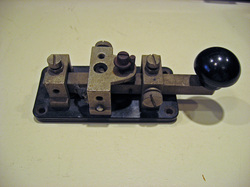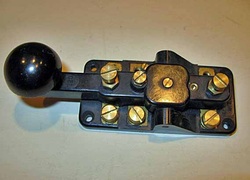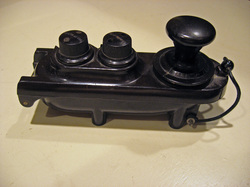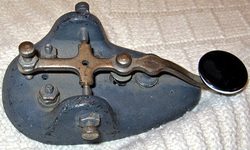Keys from the United Kingdom
These are telegraph keys from the countries in the United Kingdom, including England, Australia and Canada. Most UK keys are distinguished by their mushroom shaped knobs and straight levers. I have placed information about other international telegraph keys here.
You can click on any of these images to enlarge them. Other international keys are here.
You can click on any of these images to enlarge them. Other international keys are here.

Australian/British McMurdo Telegraph Key:
This tiny key was used on many post WW-II British and Australian radios. It was manufactured by McMurdo Industries in England and it has a canvas strap that can be attached to the operator's leg. It is completely sealed and waterproofed and was used on life rafts. The same style of key was used by the British Military in the 1950s, 1960s and 1970s with the A13 and A14 man packs. The Australian army used a similar key made by AWA from 1970 to 1995. [039]
This tiny key was used on many post WW-II British and Australian radios. It was manufactured by McMurdo Industries in England and it has a canvas strap that can be attached to the operator's leg. It is completely sealed and waterproofed and was used on life rafts. The same style of key was used by the British Military in the 1950s, 1960s and 1970s with the A13 and A14 man packs. The Australian army used a similar key made by AWA from 1970 to 1995. [039]

Australian Post Office/Military Telegraph Key:
A small straight key from Australia. “P. M. G. 1942 E. W. T”. is stamped on the base. “PMG” means Post Master General. This key is similar to the British WT-8A keys that were used by the British armed forces throughout WW-II. This key has a conventional steel lever. I purchased this key from a seller in New South Wales, Australia. [022]
A small straight key from Australia. “P. M. G. 1942 E. W. T”. is stamped on the base. “PMG” means Post Master General. This key is similar to the British WT-8A keys that were used by the British armed forces throughout WW-II. This key has a conventional steel lever. I purchased this key from a seller in New South Wales, Australia. [022]

British WT-8A Telegraph Key - Phenolic:
This British key has a mushroom knob and black phenolic base. These keys were made in over 100 versions in six countries starting in the 1920s. They were used extensively by British troops in WW II. The 8A means 8 amp capacity. These keys work in reverse polarity compared to other keys since the lever is not conductive. It uses slot screws with lock nuts rather than the conventional knurled-top screws for the electrical connections. [015]
This British key has a mushroom knob and black phenolic base. These keys were made in over 100 versions in six countries starting in the 1920s. They were used extensively by British troops in WW II. The 8A means 8 amp capacity. These keys work in reverse polarity compared to other keys since the lever is not conductive. It uses slot screws with lock nuts rather than the conventional knurled-top screws for the electrical connections. [015]

British RAF Bathtub Telegraph Key:
This unusual looking Bathtub key was used in WWII British Lancaster bombers. The contacts are completely enclosed to prevent sparks. The top of the key is hinged and opens to show the "upside down" key that is inside. The metal clip on the right keeps the cover closed but it can be slipped over the knob to hold it down. This allowed a radio operator to parachute from a plane while still sending out homing signals. [032]
This unusual looking Bathtub key was used in WWII British Lancaster bombers. The contacts are completely enclosed to prevent sparks. The top of the key is hinged and opens to show the "upside down" key that is inside. The metal clip on the right keeps the cover closed but it can be slipped over the knob to hold it down. This allowed a radio operator to parachute from a plane while still sending out homing signals. [032]

Muirhead B2 Indian Spy Key:
This two inch long straight key was used in the British spy sets A MK III and B2 Suitcase sets in the early 1940's. It resembles most British keys with its mushroom knob and straight lever. The person who sold it to me found it "in a junk shop while traveling in India." [041]
This two inch long straight key was used in the British spy sets A MK III and B2 Suitcase sets in the early 1940's. It resembles most British keys with its mushroom knob and straight lever. The person who sold it to me found it "in a junk shop while traveling in India." [041]

Grimmer Wilson Telegraph Key:
This is not a McElroy key, but it sure looks like one with its teardrop shape. This is a Grimmer Wilson key that was made in Canada and used by the RCAF. It has a steel lever and pivot pins like a McElroy but it lacks the shorting bar and conductive strips on the top of the key. [060]
This is not a McElroy key, but it sure looks like one with its teardrop shape. This is a Grimmer Wilson key that was made in Canada and used by the RCAF. It has a steel lever and pivot pins like a McElroy but it lacks the shorting bar and conductive strips on the top of the key. [060]